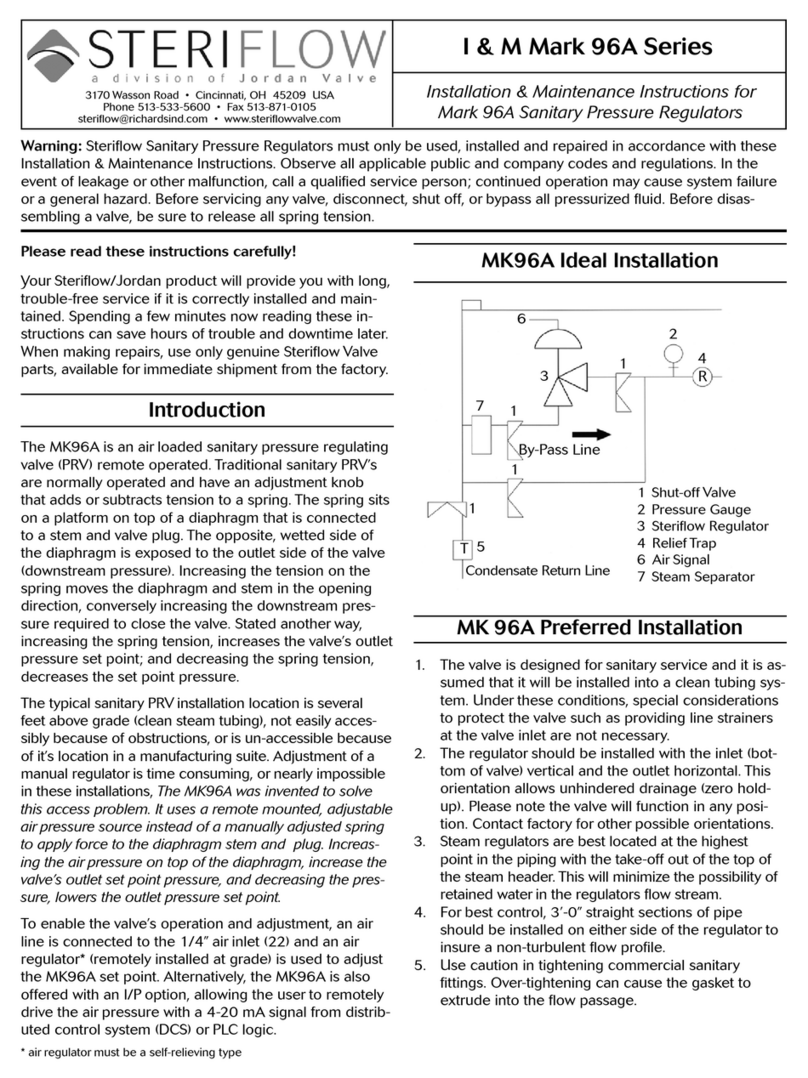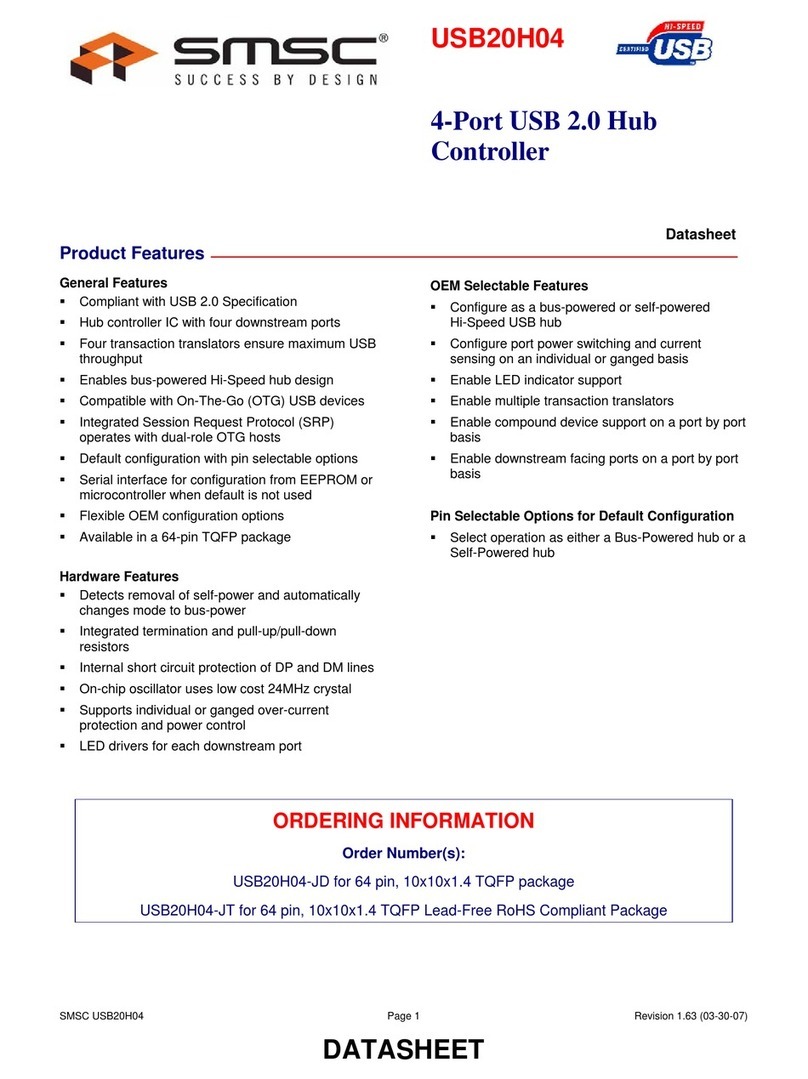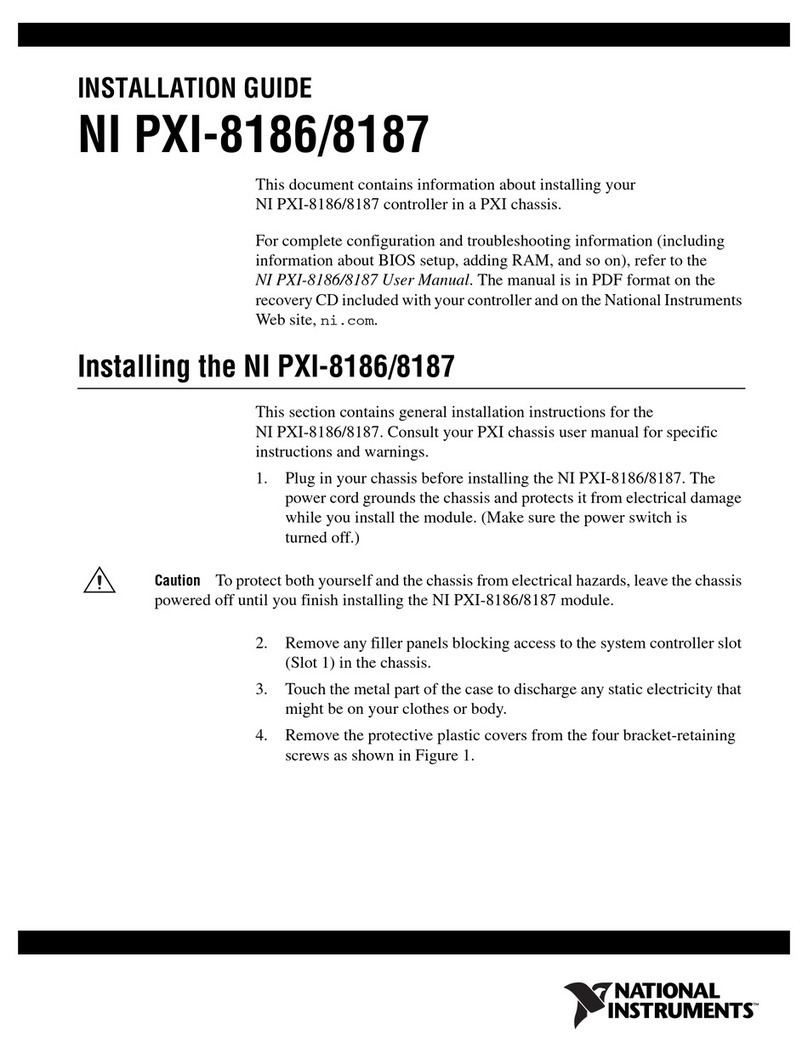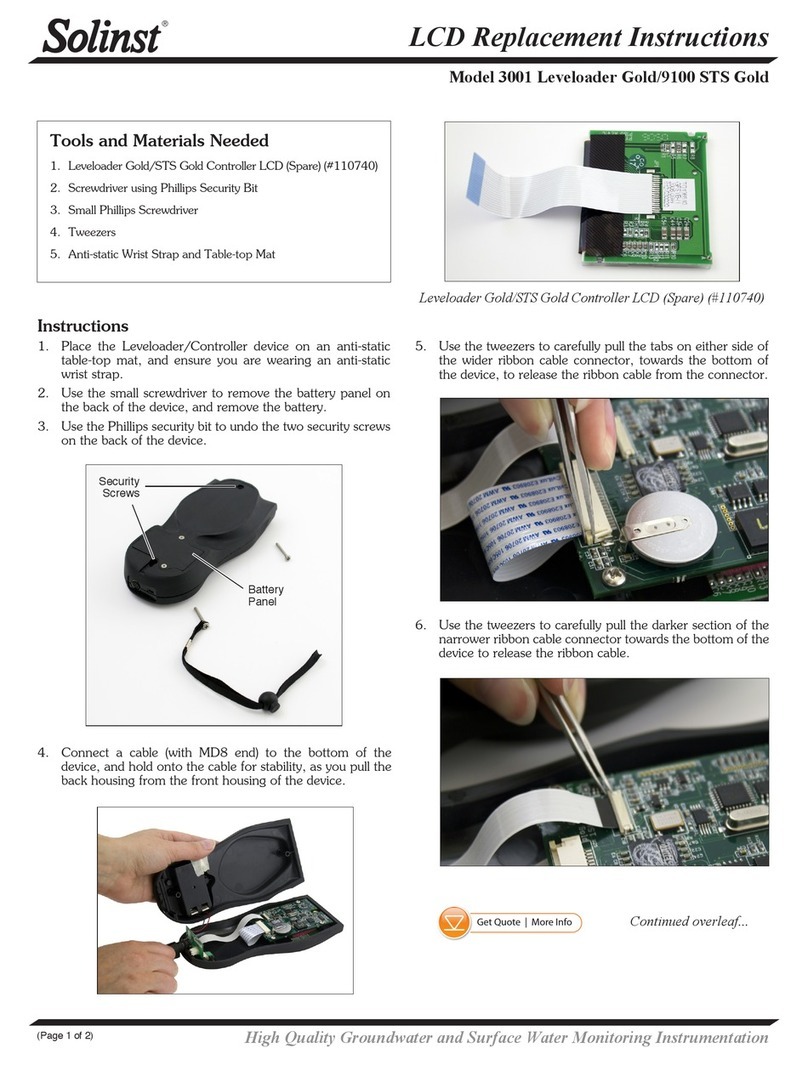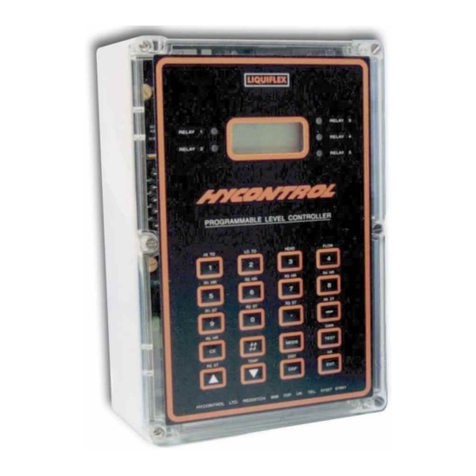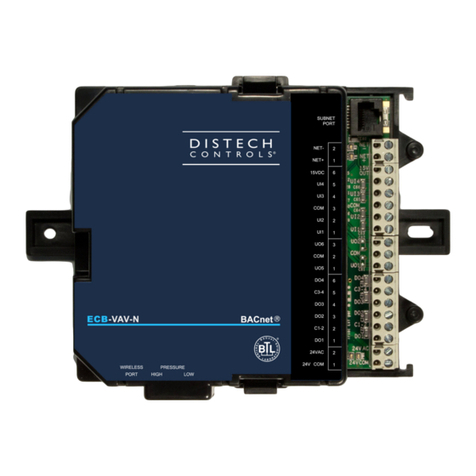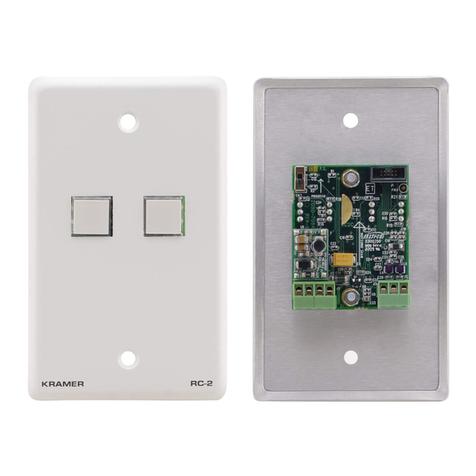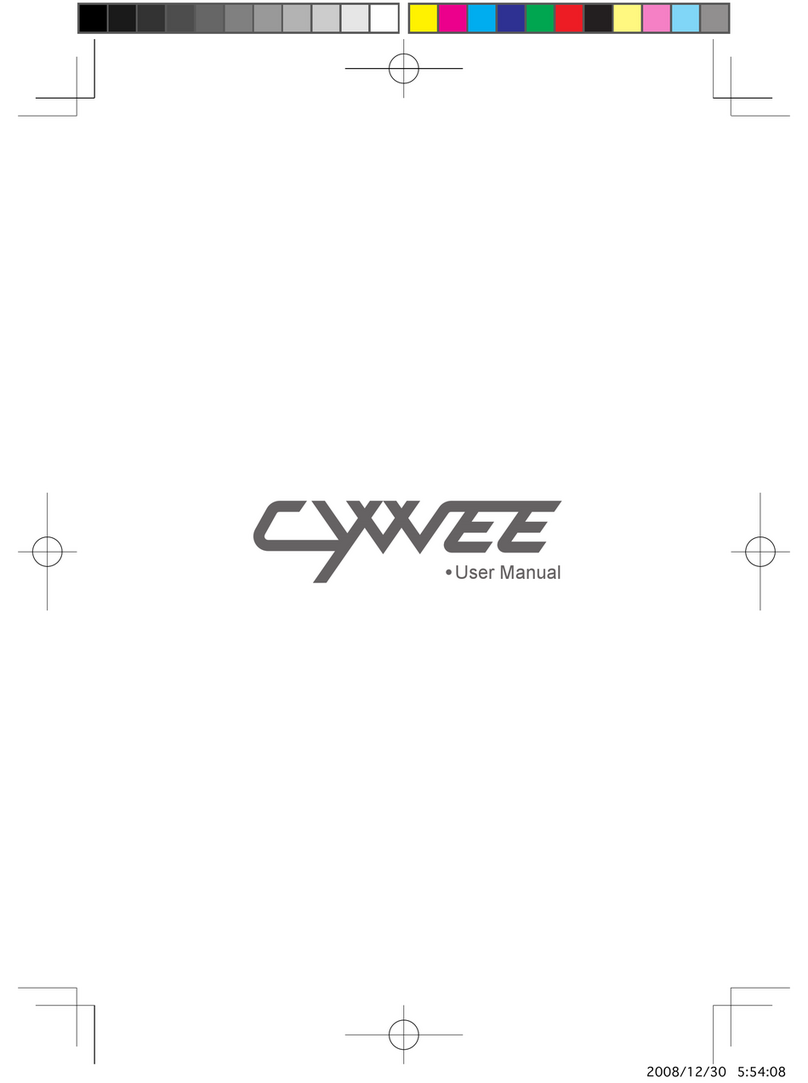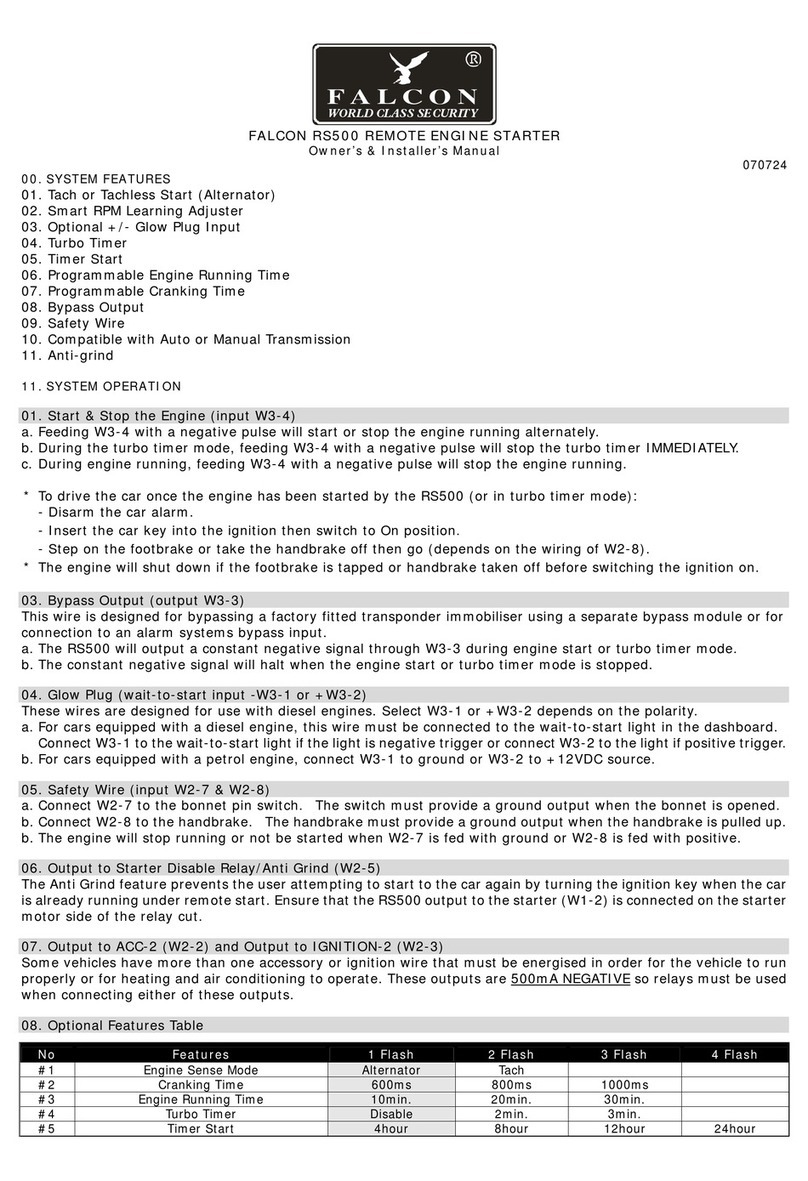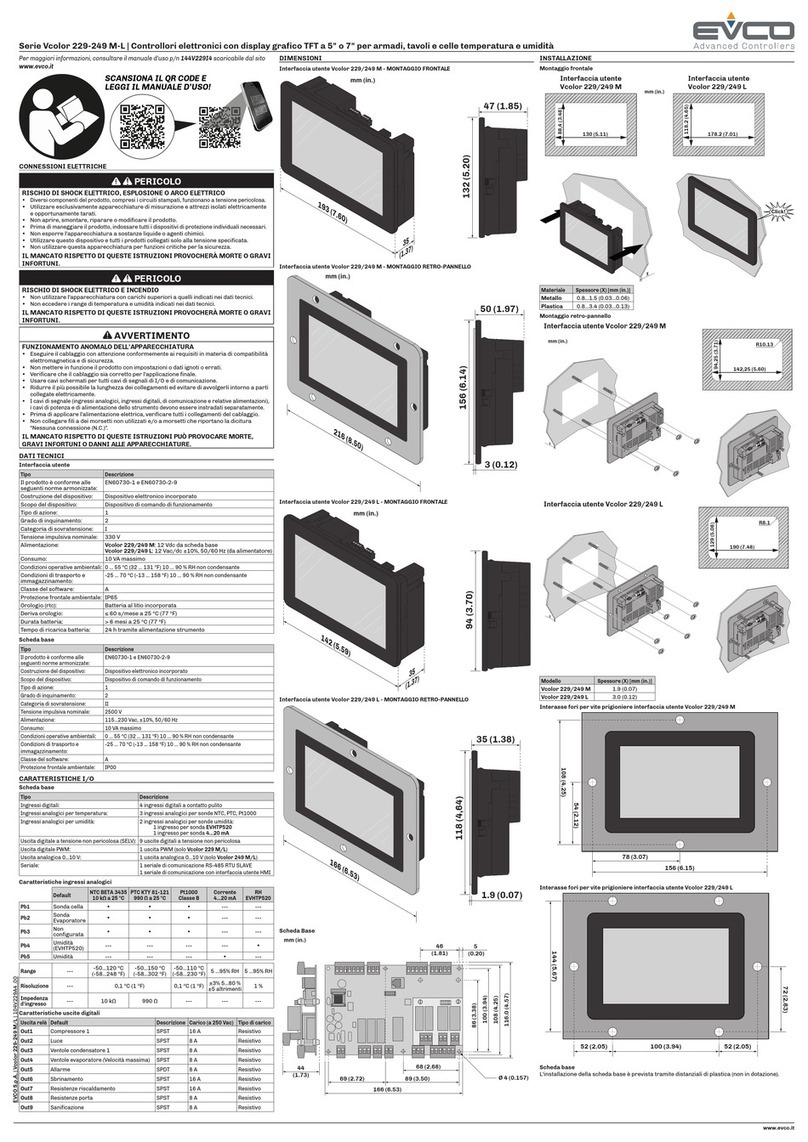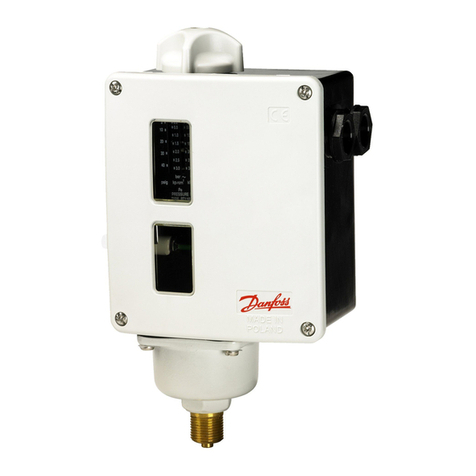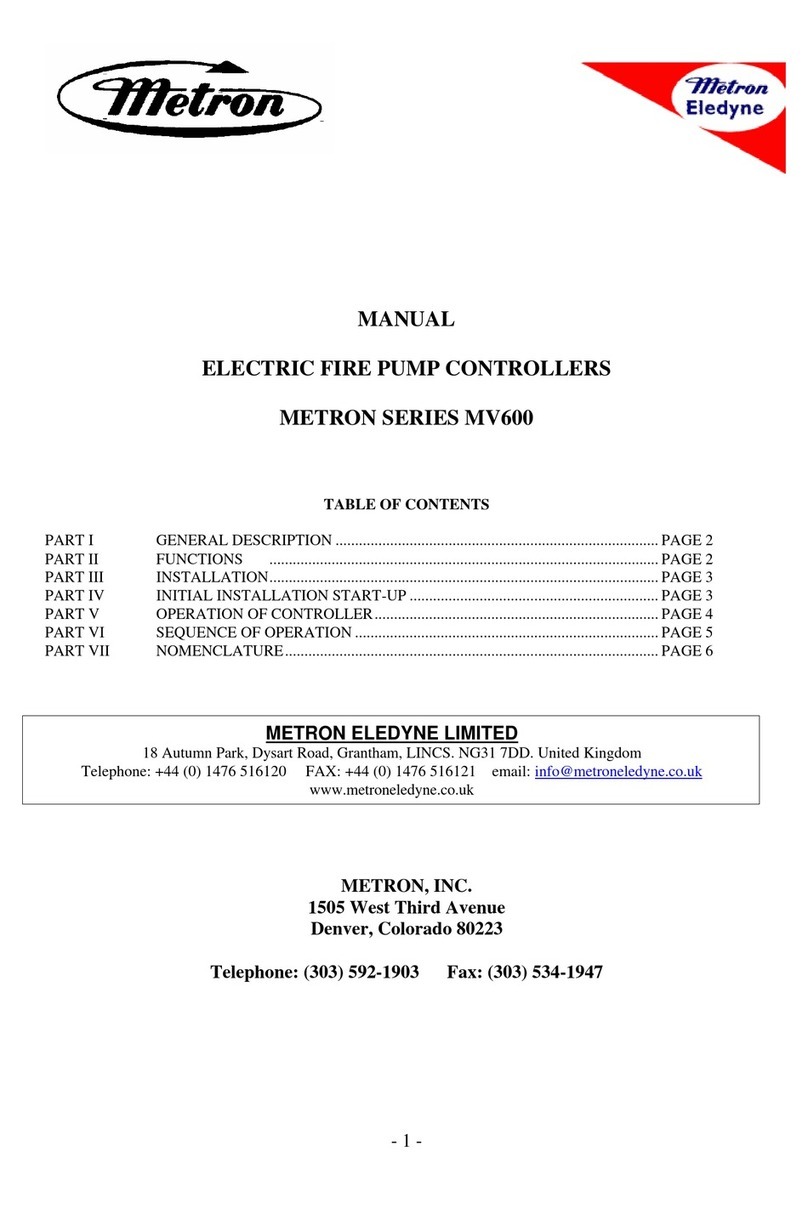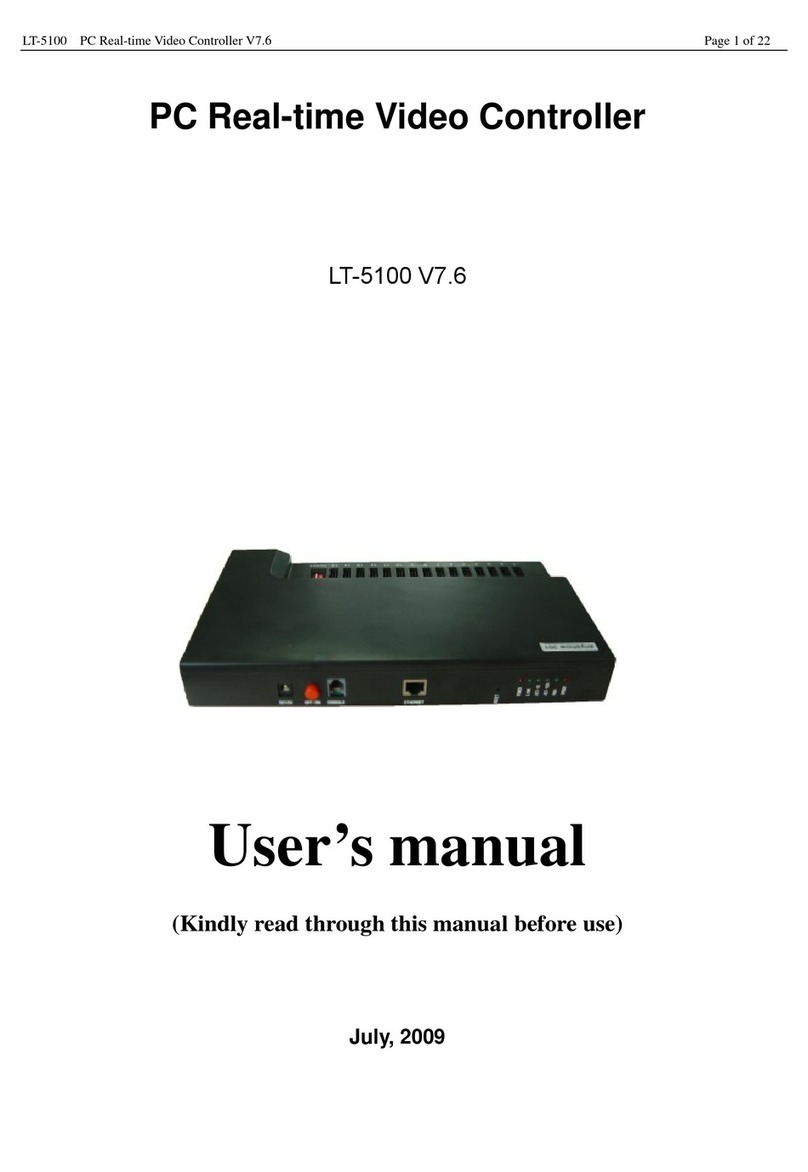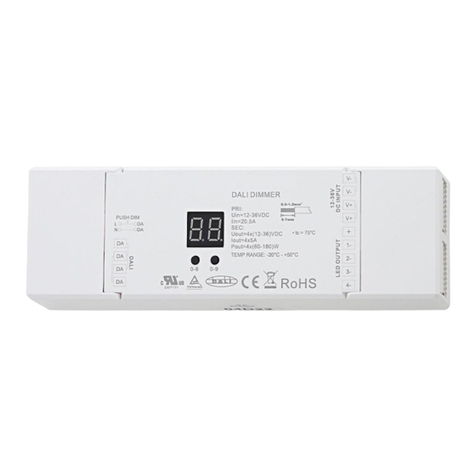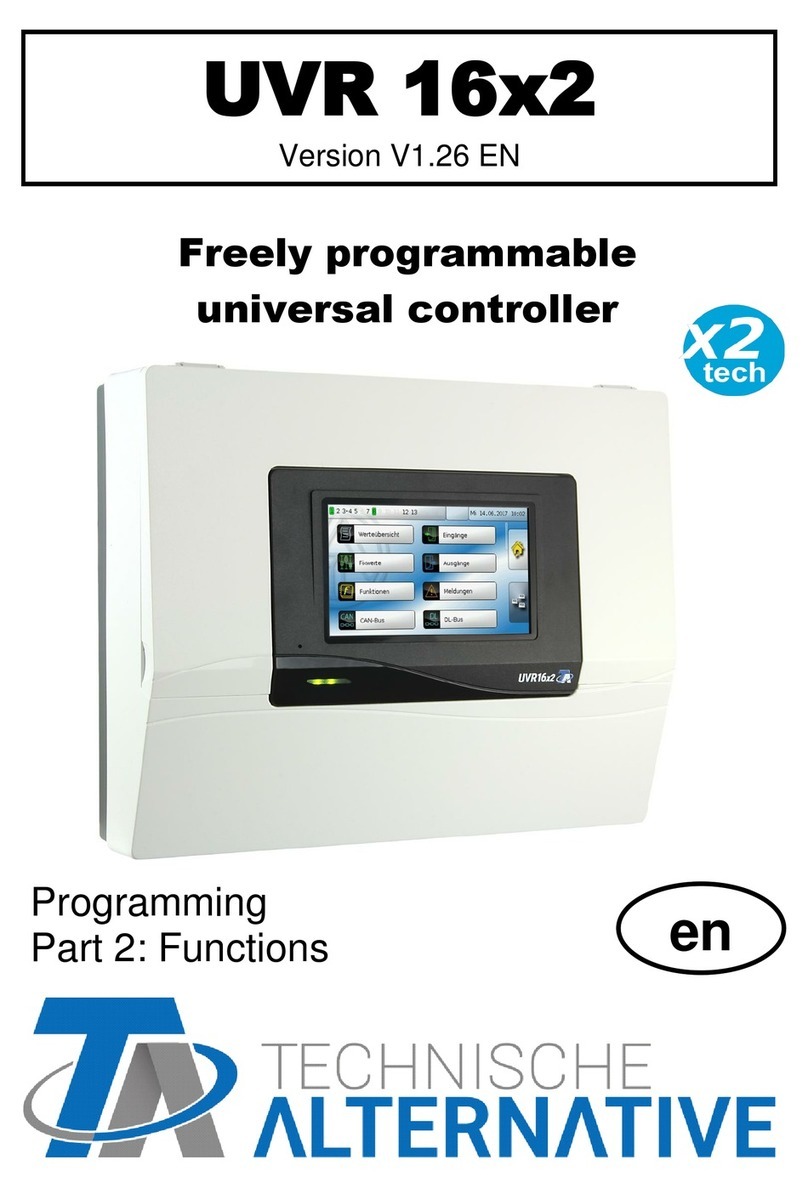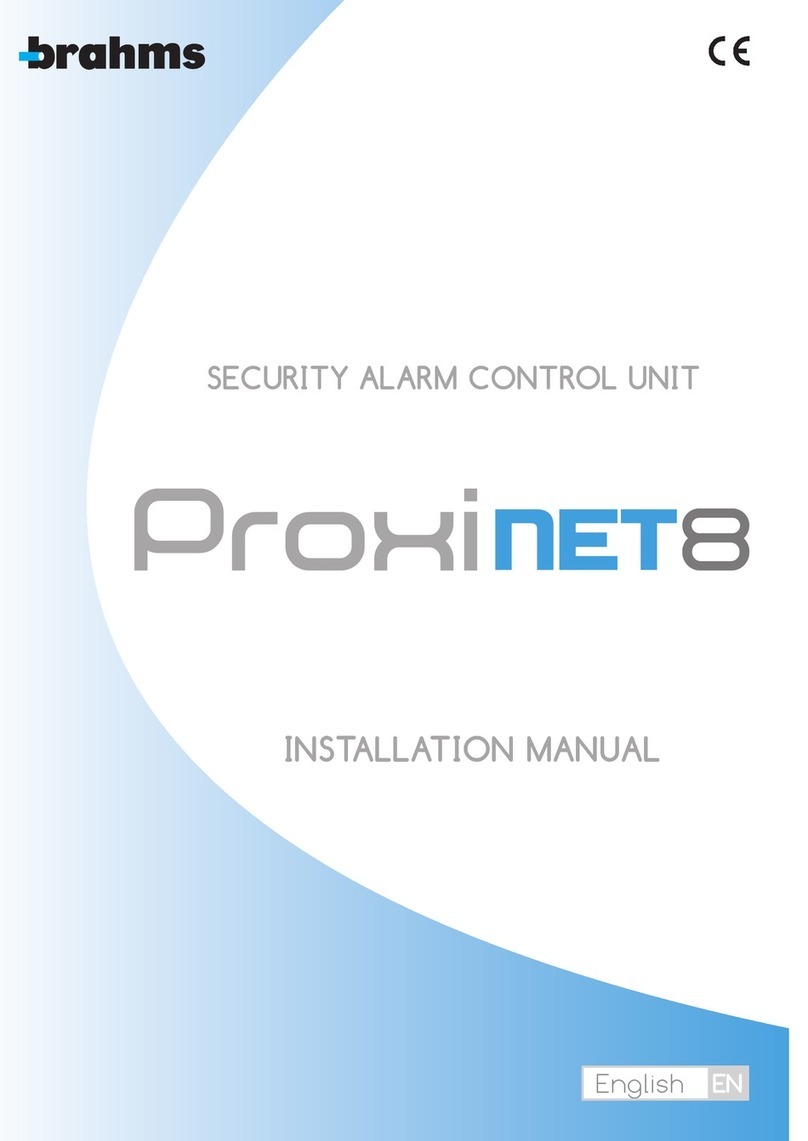STERIFLOW Mark 95 Series Installation and operating instructions

Please read these instructions carefully!
Your Steriflow/Jordan Valve product will provide you with
long, trouble-free service if it is correctly installed and main-
tained. Spending a few minutes now reading these instruc-
tions can save hours of trouble and downtime later. When
making repairs, use only genuine Jordan Valve parts, avail-
able for immediate shipment from the factory.
Ideal Installation Schematic
Preferred Installation
1. The valve is designed for sanitary service and it is as-
sumed that it will be installed into a clean system. Un-
der these conditions, special considerations to protect
the valve such as providing line strainers at the valve
inlet are not necessary.
2. The regulator is to be installed with the inlet horizontal
and the outlet pointed down. This will provide the best
drainage inside the valve. These restrictions apply only
for drainage considerations; the valve will function in
any position. Contact factory for other possible orienta-
tions.
3. Steam regulators are best located at the highest point
in the piping with the take-off out of the top of the steam
header. This will minimize the possibility of water in the
regulator.
3170 Wasson Road • Cincinnati, OH 45209 USA
Phone 513-533-5600 • Fax 513-871-0105
I&M 95
Installation & Maintenance Instructions for
Mark 95 Sanitary Back Pressure Regulators
Warning: Steriflow Sanitary Pressure Regulators must only be used, installed, and repaired in accordance with these
Installation & Maintenance Instructions. Observe all applicable public and company codes and regulations. In the event of
leakage or other malfunction, call a qualified service person; continued operation may cause system failure or a general
hazard. Before servicing any valve, disconnect, shut off, or bypass all pressurized fluid. Before disassembling a valve, be
sure to release all spring tension.
4. For best control, 3’-0” straight sections of pipe should
be installed on either side of the regulator.
5. Use caution in tightening commercial sanitary fittings.
Over-tightening can cause the gasket to extrude into
the flow passage.
6. If possible, install a relief valve downstream from the
regulator. Set at about 30% above the control point of
the regulator.
7. In gas or vapor service, select outlet piping that is at
least one pipe size larger than the inlet.
8. Operate the regulator within its pressure and tempera-
ture rating as stamped on the valve nameplate.
Start-Up
1. Slowly open the inlet shutoff valve and slowly turn the
adjusting screw until the desired inlet pressure is shown
on the inlet pressure gauge, without discharging fluid.
2. To change the controlled pressure, turn the adjusting
screw clockwise to increase the pressure, or counter-
clockwise to decrease the pressure.
3. Once the desired setpoint is obtained, run the thumb-
lock down until it reaches the top of the spring housing.
Then run the hex jam nut down to the top of the thumb-
lock and lock the two together. This will effectively keep
the adjusting screw from turning due to vibration, etc.
This is useful during the cleaning cycle (see section on
Clean-In-Place/Steam-In-Place.)
Warning: Never substitute an longer length adjusting
screw. The valve may fail to open and personal injury or
property damage could occur
.
Maintenance
Caution: Make certain that there is no pressure in the
valve before loosening any fittings or joints. The fol-
lowing steps are recommended:
1. Close the inlet shutoff valve.
2. Turn the adjusting screw counterclockwise until there is
no pressure on the spring, allowing any trapped pres-
sure to release downstream.
PROTECT VALVES WITH LINE STRAINERS
STERIFLOWTM
Sanitary Products by Jordan Valve

3. Allow pressure to bleed off through the downstream
piping. Do not attempt to reverse the flow through the
valve by bleeding pressure from the upstream side of
the valve
4. When the pressure gauges indicate that all pressure
has been removed from the system, close the outlet
shutoff valve. The valve may be removed from the line
and serviced.
Note: refer to the drawing at the end of this document
for description and proper orientation of parts.
Clean-In-Place/Steam-In-Place
To manually open the valve for cleaning, back off the ad-
justing screw to remove all range spring load. Maintain the
position of the thumb-lock and hex jam nut on the stem so
that the adjusting screw can be returned to its normal posi-
tion to maintain the set point. There is a CIP spring inside
the spring housing that will open the valve automatically
once the range spring load is removed. This will allow the
valve to drain completely during the cleaning cycle .After
cleaning return the adjusting screw back to the original set
point by using the thumb-lock and an indicator.
NOTE: 2” Valves do not use a thumb-lock, but instead
use two jam nuts.
Disassembling Valve
1. Follow the instructions under the “Maintenance” section
to remove the valve from line.
2. Back off the adjusting screw to remove the load from
the range spring.
3. Remove the spring housing by removing the hex head
cap screws.
4. Remove the spring and spring guide.
5. Remove the cylinder by removing the hex jam nut along
with lockwasher on valves with a Stainless Steel dia-
phragm. This will allow you to remove the CIP/SIP
spring and adapter.
6. Remove the spacer, upper diaphragm plate and dia-
phragm from the stem. Remove the lower diaphragm
plate and o-ring where applicable.
CAUTION: If the valve is equipped with a metal diaphragm,
the edges are very sharp. Exercise caution to avoid lacera-
tions.
7. Remove the stem and the o-ring [on ¾” and 1” valves
with a metal diaphragm only] from the body.
Preparing Valve For Assembly
1. All parts should be cleaned and examined. Damaged
parts should be replaced.
2. O-rings should be lubricated. You may use any lubri-
cant that is compatible with both your process and the
o-ring material. EPDM o-rings must not be exposed to
mineral oil as it will cause them to swell and make
them difficult to install.
NOTE: for all assembly lubrication requirements, Jor-
dan Valve/Steriflow uses Bostik NEVER_SEEZ, White
Food Grade with PTFE, Cat. No. NSWT-14
(improved
version without mineral oils).
3. For soft-seated valves: clean threads on the stem and
on retainer with Loctite primer “T”. Allow to dry. Install
new soft seat onto retainer [or onto stem when appli-
cable on low flow versions]. Apply Loctite No. 620 to
threads and thread the retainer onto the stem. Tighten
until the screw threads run out. Allow to cure.
Assembling the Valve
1. Lubricate o-ring and install into the groove in the body
[not required on valves with elastomer diaphragm].
2. Lubricate o-ring and install into the groove in the lower
diaphragm plate. Install lower diaphragm plate onto stem
[not required on valves with elastomer diaphragm].
3. Install O-Ring to steam.
4. Install diaphragm onto stem.
5. Install upper diaphragm plate onto stem.
6. Install spacer onto stem.
7. Install stem into body. Center diaphragm onto body.
8. Install adapter onto body. The adapter should engage
the pilot diameter on the body.
9. Install the CIP/SIP spring onto the spacer.
10. Install the cylinder onto the stem.
11. Install lockwasher onto stem [not required on valves
with elastomer diaphragm].
12. Install hex jam nut onto stem and tighten. If valve has
an elastomer diaphragm, tighten only ¼ turn and apply
Loctite No. 290 to the threads to lock joint.
13. Install spring into the cylinder.
14. Install spring guide onto the spring.
15. Lubricate the O.D. surfaces of the cylinder and install
the spring housing.
16. Attach the nameplate to the body with one of the hex
head cap screws.
17. Install hex jam nut and thumb-lock (or second hex jam
nut) onto the adjusting screw and lubricate the thread
on the adjusting screw. Thread adjusting screw into the
spring housing only about four threads.
18. Secure spring housing to the body. Hand-tighten two of
the hex head cap screws. Place a light spring load on
the stem by turning the adjusting screw clockwise. This
will center the plug on its seat. Torque hex head cap
screws to 200 in/lbs. (17 ft/lbs.).

Troubleshooting
Erratic Control
Regulator may be oversized. Oversizing causes cycling and
hunting, and reduces the rangeability of the valve – make
certain that your valve has been correctly sized according
to your application conditions.
Valve seat may be defective - replace stem and/or body.
Valve plug may not be moving freely – inspect the cylinder
and spring housing.
Upstream Pressure Build-up or Inability to Maintain
Regulated Pressure
Inspect for jamming between cylinder and spring housing.
Diaphragm may have failed – replace if necessary.
Piping may be blocked or undersized.
Range spring may be set too high or may be broken – in-
spect and reset or replace as necessary.
The valve may be undersized for required flow – make cer-
tain that the valve has been sized correctly.
ORDERING SPARE PARTS
Use only genuine Jordan Valve parts to keep your valve in
good working order. So that we can supply the parts, which
were designed for your valve, we must know exactly which
product you are using. The only guarantee to getting the
correct replacement parts is to provide your Jordan Valve
Representative with the valve serial number. This num-
ber is located on the valve identification tag. If the serial
number is not available, the parts needed for your valve
might be able to be determined with the following informa-
tion:
· Model Number
· Valve Body Size
· Seat Material and CV rating
· Spring Range and Set Point
· Trim Material
· Part Name – Number and Quantity
(See parts list chart on the back)
NOTE: Without a valve serial number, any parts ordered
incorrectly are subject to up to a minimum 25% restock
charge when returned.
Ordering Spare Parts

Illustration & Parts List
3170 Wasson Road • Cincinnati, OH 45209 USA
Phone 513-533-5600 • Fax 513-871-0105
Phone Toll-Free: 800-543-7311
E-Mail: [email protected]
www.jordanvalve.com
STERIFLOWTM
Sanitary Products by Jordan Valve
Mark95 I&M/0907
17
36
15
13
11
14
10
3
4
5
9
8
35
7
21
31
37
38
30
26
25
2
1
.oNnoitpircseDYTQ
1A/SydoB1
2metS1
3etalPmgarhpaiDreppU1
4mgarhpaiD1
5gniR-O1
7recapS1
8rehsawkcoL1
9tuNmaJxeH1
01rednilyC1
11gnirpSegnaR1
31ediuGgnirpS1
41gnisuoHgnirpS1
51kcolbmuhT1
71A/SwercSgnitsujdA1
12SCHH8
52gniR-O1
62etalPmgarhpaiDrewoL1
03gniR-O1
13re
tpadA1
53gnirpSPIS/PIC1
63tuNmaJxeH1
73dnalG1
83gnihsuB1
Notes:
Items 5, 8 and 30 are not required when using an elas-
tomer diaphragm.
Items 5 is not required when using a Jorlon diaphragm.”
Other STERIFLOW Controllers manuals
